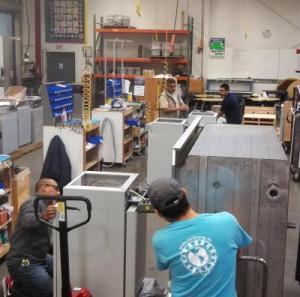Feb 21 2014
Engineers at Oregon State University have developed a new approach toward "sustainable manufacturing" that begins on the factory floor and tries to encompass the totality of manufacturing issues – including economic, environmental, and social impacts.
 Sheldon Manufacturing, an Oregon firm, is working with Oregon State University to improve its approaches to sustainable manufacturing. Credit: Photo courtesy of Sheldon Manufacturing
Sheldon Manufacturing, an Oregon firm, is working with Oregon State University to improve its approaches to sustainable manufacturing. Credit: Photo courtesy of Sheldon Manufacturing
This approach, they say, builds on previous approaches that considered various facets of sustainability in a more individual manner. Past methods often worked backward from a finished product and rarely incorporated the complexity of human social concerns.
The findings have been published in the Journal of Cleaner Production, and reflect part of society's growing demands for manufacturing systems that protect both people and the environment, while still allowing companies to be economically viable and make a profit on their products.
"People around the world – and many government policies – are now demanding higher standards for corporate social responsibility," said Karl Haapala, an OSU assistant professor of industrial and manufacturing engineering. "In the early days, industry dealt with 'end-of-pipe' challenges to reduce pollution or increase efficiency. There's still a place for that, but we're trying to solve the problem at the source, to begin the process right at the drawing board or on the shop floor."
"We want to consider a whole range of issues every step of the way," Haapala added, "so that sustainability is built into the entire manufacturing process."
The researchers demonstrated the approach with the production of stainless steel knives, based on an industry project. But the general concepts could be used for virtually any system or product, they said.
With every decision the method considers manufacturing techniques, speed of the operations, environmental impacts, materials, energy used and wastes. Decisions can be based on compliance with laws and regulations, and the effects of different approaches on worker safety and satisfaction.
"This is one of the few approaches to systematically consider the social aspects of the workplace environment, so that people are happy, productive, safe, and can contribute to their families and communities," said Hao Zhang, a doctoral student in the College of Engineering and graduate research assistant on the study.
"Suppose we make changes that speed up the output of a manufacturing line," Zhang said. "In theory that might produce more product, but what are the impacts on tool wear, increased down time or worker satisfaction with the job? What about risk of worker injury and the costs associated with that? Every change you make might affect many other issues, but too often those issues are not considered."
Social components have often been left out in the past, Zhang said, because they were some of the most difficult aspects to scientifically quantify and measure. But health, safety and happiness that start on the workshop floor can ripple through the entire community and society, Haapala said, and they are too important to be pushed aside.
This approach incorporates previous concepts of sustainability that have been found to have proven value, such as "life cycle assessment" of systems that considers the totality of energy used, environmental impacts and other issues. And it lets manufacturers make value judgments about the issues most important to them, so that a system can prioritize one need over another as necessary.
OSU researchers are further developing these approaches in collaboration with Sheldon Manufacturing, Inc., of Cornelius, Ore., a designer and manufacturer of laboratory equipment. This work has been supported by Benchmade Knife Co., Sheldon Manufacturing and the Oregon Metals Initiative.
These demands are a special challenge to small and medium sized companies that may not always have the necessary broad range of engineering expertise, the OSU engineers said. They hope the systems being developed can be implemented at many levels of manufacturing.
Source: http://oregonstate.edu/